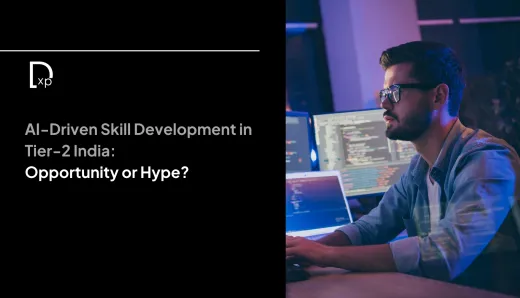Hiring Bias, GPT, and the New Ethics of Talent Screening in India

Let’s not sugarcoat it. The future of hiring in India is being shaped by algorithms, but the rules haven’t caught up. As HR automation becomes mainstream, especially with the adoption of AI and large language models like GPT, the ethical cracks are starting to show. Not just globally, right here in India.
Bias in hiring has always existed. But now it’s faster, invisible, and harder to question. You’re not just dealing with human prejudice anymore. You’re dealing with encoded assumptions that can reinforce caste privilege, gender imbalance, and urban elitism at scale.
This blog is not about bashing HR tech. It’s about confronting a real and rising challenge in how India is hiring, and what HR automation must do differently to be truly inclusive.
HR Automation in India Is Surging, But Who Is It Optimizing For?
From resume screening to interview scheduling, HR automation has taken over key workflows across Indian enterprises and startups. It saves time. It improves consistency. It looks futuristic on a pitch deck.
But let’s ask the real question: who benefits from this speed and structure? And who gets left out?
Most HR automation systems in India are trained or configured with datasets that reflect existing corporate hierarchies. These hierarchies skew urban, English-speaking, upper-caste, and male. This means when automation kicks in, the system is not just filtering for skills. It’s quietly reinforcing a specific professional archetype. And that archetype doesn’t represent India; it represents privilege.
Caste Still Shapes Hiring in India; Just in More Polished Ways
Nobody puts “caste preference” in job descriptions anymore. But it shows up in other forms. Surnames. College names. Cities. Communication “polish.” A Dalit candidate from a Tier-3 city with top GitHub contributions is more likely to be ignored by an algorithm than someone from a metro-based private university with the “right” network and vocabulary.
This is not theoretical. It’s already happening. Especially in domains like tech, product, finance, and consulting, where HR automation is heavily used.
The real danger? Most recruiters and HR heads don’t even know it’s happening. They trust the tool. The tool trusts the data. The data reflects the bias. And bias becomes the system.
Gender Bias Has Gone Digital, Too
Indian women in the workforce already face massive structural barriers, from pay gaps to drop-offs post-maternity. But now, HR automation adds another layer.
Let’s say a woman has a career break of 18 months. Maybe due to caregiving, childbirth, or health. Most automated screeners flag this as “inconsistent experience.” Or they downgrade her for lack of “recent exposure.” No context. No nuance. Just rejection.
Some systems even filter based on working hours or relocation flexibility, automatically disqualifying women who opt for hybrid or part-time roles. It’s subtle. It’s clean. But it’s discrimination.
And when you layer this on top of gender-coded language in JDs, lack of female hiring signals, and bias in interview training data, what you get is an entire ecosystem where women in India are algorithmically sidelined.
The Urban Bias Is the Most Invisible, And the Most Dangerous
AI in hiring is often trained on what “good” looks like. But what if “good” only comes from candidates who studied in Mumbai, Delhi, Bengaluru, or Hyderabad? What happens when your automation stack doesn’t know how to read a BSc grad from Raipur who built her own chatbot in Bhojpuri?
Urban bias is the invisible filter. It penalizes regional languages, non-traditional education, local projects, and rural internships. It assumes exposure equals competence. And it fails to see brilliance outside of corporate English and big-city internships.
This is how HR automation ends up building pipelines that look diverse on paper, but aren’t really inclusive.
GPT Models Can Either Reinforce the Problem, Or Solve It
Let’s talk about GPT. Large Language Models like GPT are now being embedded into recruitment platforms across India. They’re being used to write job descriptions, screen candidate responses, and even run chat-based interviews.
If not fine-tuned correctly, GPT can absorb and repeat existing bias, because it's trained on the internet, and the internet has no shortage of casteist, sexist, elitist patterns.
But here’s the flip side: GPT can also be used to counter bias. It can anonymize resumes. Normalize regional expressions. Highlight hidden strengths. Provide contextual prompts to recruiters that bring equity into the screening process.
It’s all about how it's implemented. And who gets to decide what “fit” looks like.
The New Ethics of Talent Screening in India Starts With One Question
Are we building hiring systems that reward privilege? Or are we building systems that level the playing field?
India doesn’t need just faster hiring. It needs fairer hiring. HR automation must move beyond efficiency metrics. It must actively address the caste, gender, and regional disparities that are deeply wired into how opportunity works in this country.
This means:
- Rewriting data assumptions.
- Redesigning candidate journeys.
- Relearning what merit actually looks like in a diverse population.
- You can’t outsource this to tech alone. It needs leadership. And it needs ethics.
The Bottom Line
HR automation in India is not just a tool. It’s a powerful force that will shape who gets access to opportunity, at what speed, and under what conditions. If we don’t fix the biases now, we’ll scale them into every sector, every city, and every future generation of professionals.
Hiring needs to be smarter, yes. But it also needs to be just.
Let’s make sure we’re not just building systems that work. Let’s build right systems.




